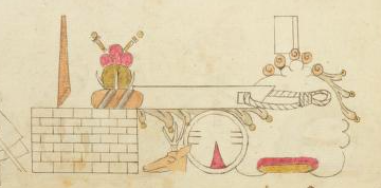huictli (Azca26)
This painted black-line drawing of the iconographic example (unglossed) of a digging stick (which we are calling a huictli) shows a frontal view of a vertical, brown, agricultural tool that has been painted brown, suggesting that it is wooden. The pointed, wide end is at the bottom, and the handle is upward. The contextualizing image shows a brick wall and a beam or board; perhaps the digging stick was part of a construction project in this case.
Stephanie Wood
See various other examples of the huictli, below. One has parallel hash marks on the wide end. These might be a reference to maize cultivation, if these hash marks are intentionally like those found on cobs of corn and tortillas. One example appears below.
Evidence that the huictli came to be called a coa in Mexican Spanish comes from the Spanish-language text in the Florentine Codex.
Stephanie Wood
post-1550, possibly from the early seventeenth century.
Jeff Haskett-Wood
agricultura, herramientas, coas
huic(tli), a flat blade digging stick, an agricultural tool, https://nahuatl.wired-humanities.org/content/huictli
el coa, una herramienta agrícola
Stephanie Wood
The Codex Azcatitlan is also known as the Histoire mexicaine, [Manuscrit] Mexicain 59–64. It is housed in the Bibliothèque Nationale de France, and hosted on line by the World Digital Library and the Library of Congress, which is “unaware of any copyright or other restrictions in the World Digital Library Collection.”
https://www.loc.gov/resource/gdcwdl.wdl_15280/?sp=26&st=image
The Library of Congress is “unaware of any copyright or other restrictions in the World Digital Library Collection.” But please cite Bibliothèque Nationale de France and this Visual Lexicon of Aztec Hieroglyphs.



